RECOIL OFFGRID Preparation Dark Angel Medical: No Excuse for Ignorance
In This Article
As you cruise along the highway listening to your favorite podcast, you watch in disbelief and horror as a car a few lengths in front of you swerves violently, knocking a biker clear across three lanes of traffic. You pull over immediately and feel that natural desire to help. But what are you going to do? Do you have the knowledge and willingness to become part of the scene? Are you a bystander or a “by-doer?” Never at a loss for a smile or a Southern phrase that will keep you grinning from ear-to-ear like a mule eatin’ saw briars, Kerry Davis of Dark Angel Medical wants to create a vast army of “by-doers” — regular people with the ability and willingness to help save a human life. Effortlessly blending complex medical information with an easy to understand trauma care curriculum, Davis provides training for everyone, as well as a suite of medical kits specifically designed to complement your everyday lifestyle.
Affectionately known as “Pocket Doc” to those closest to him, Davis is a humble, quiet professional who lives and breathes what he teaches, referring to himself as “just a nurse.” Dig a little deeper and you’ll find that this Air Force vet has more than 29 years of medical experience as a military flight medic, paramedic, and ER nurse. In addition to running Dark Angel Medical, Davis is also an adjunct instructor at SIG Sauer Academy. He has dedicated his adulthood to the preservation of life and hopes that through Dark Angel Medical, he can train the masses to be positively reactive instead of being as useful as a steering wheel on a mule.
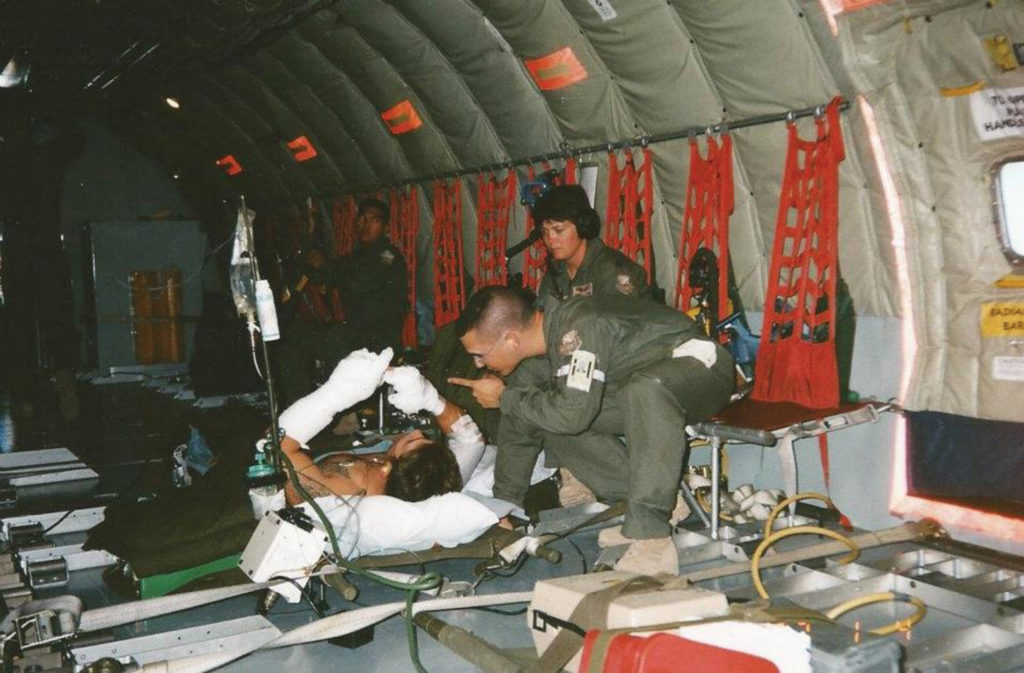
Above: Kerry working with a patient on an urgent aeromedical evacuation mission aboard an opportune aircraft ca. 1998.
RECOIL OFFGRID: When you entered the Air Force, did you plan on being a medic?
Kerry Davis: I came into the military as an open general classification, but I wanted to be a medic. Prior to that, I was in pre-med in college and I wanted to be a doctor. That was my life’s goal, to take care of people in some capacity.
We got to work very closely with the Special Tactics Squadron (STS), the Pararescue Jumpers (PJs), the Combat Controllers, Tactical Air Control Party (TACP), all those guys. I was up at Ft. Bragg for almost five years. I got a lot of really great experience with those guys and others stationed up there and they were willing to teach me what they knew. I really had a thirst to learn more and to be better, because I figured the more I learned, the better medic it would make me for the guys I was taking care of.
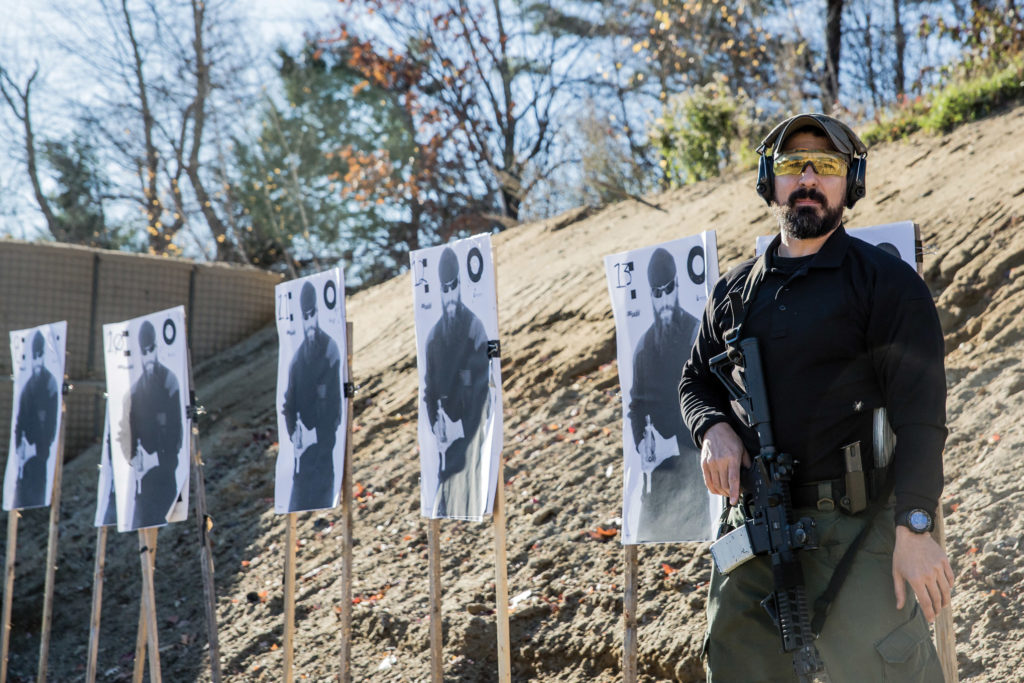
Above: Kerry discussing shot placement during a “Bullets and Bandages” class.
Were you able to apply what you learned in the field?
KD: It was mostly peacetime stuff, but there were some instances where I did get hazardous duty pay. For the most part, the majority of my trauma experience was taking care of people in the ER, or taking care of people when we would rotate over to Womack Army Medical Center. I got my street knowledge as a paramedic. That was where I really started learning, and I developed my critical thinking skills. That helped me become a better ER nurse and a critical care nurse.
Was there a defining moment in the military, the ER, or in the field where you said, “People need to know this information?”
KD: The most horrible thing in the world would be to see something bad happen to somebody you love and not know what the hell to do. That sucks. And that was probably my driving motivation, just trying to empower people with more knowledge.
When I was a paramedic in Montgomery, Alabama, back in 2003, one of my patients was a young serviceman that had been shot at a fast food drive-thru as a result of a carjacking. People were just standing there, not knowing what to do. And when we answered the call, this kid’s laying there with bloody bubbles coming out of his nose. He was still breathing. But I saw a gunshot wound in his cheek under his left eye, one through his forearm, and one in his chest in the side.
When I got him in the back of the ambulance and I was pumping all these drugs and stuff into him, the fire medic that was with me was like, “Why are you doing that, man? This dude, he’s gone. He’s a lost cause.” I’ve never been so pissed in my life. I said, “This is somebody’s kid. I’m supposed to do everything I’m supposed to do. I’m not just going to sit back here and ride the code in.” It just pissed me off, the callousness of it. I don’t want people to be that way. I want people to know how to do something. That pushed me into saying that people need to know this material. I started working on a curriculum around 2006.
Prior to Dark Angel Medical, were you providing any level of instruction?
KD: Yeah, I had been teaching advanced cardiac life support, pediatric life support, advanced life support, basic life support, and CPR. I had been teaching Self Aid Buddy Care in the military, and Prehospital Trauma Life Support. So, I’ve been teaching to adult learners since I started in 1992. I volunteered to be an instructor because I had a passion for talking to people and teaching this stuff. And then I started teaching part-time at the paramedic school, filling in when their instructors needed some help. I would cover paramedic pharmacology or cardiology classes, things like that. And I was like, “Man, there’s something to this. People can learn this. It ain’t rocket surgery.” That’s where I started getting the bug for it and said to myself, “Why don’t I just start teaching everyday folks?”
I started kicking around the idea for Dark Angel Medical in about 2010. And then, in August 2011, almost nine years ago, I formed the LLC.
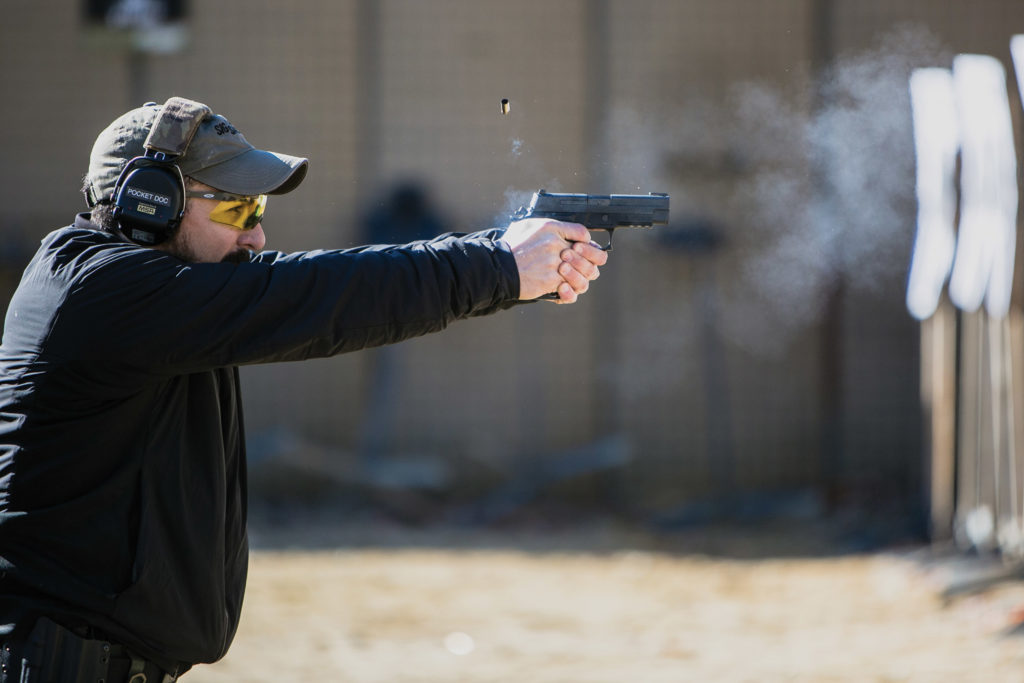
Above: Kerry starting a pistol/tourniquet drill during “Bullets and Bandages” class.
What do you think are two of the biggest trauma medicine myths that people have accepted as fact?
KD: That you can use a belt as an effective tourniquet and that you can use a tampon to pack a wound. A belt is designed to hold your britches up over your ass, period. Its intent is not to stop life-threatening hemorrhage. A belt by itself is no more than a constricting band. There’s not enough pressure that can be applied to occlude a major arterial bleed. Some people will say, “Well, such and such is Billy Bob’s brother down the street’s sister’s cousin’s uncle, and he used it one time.” Dude, a broken watch is right twice a day.
Studies have shown that unless you throw some sort of mechanical advantage — i.e. a windlass — on this belt and create enough circumferential pressure in that limb to occlude that artery, it ain’t going to work. So, use an approved commercially available tourniquet. And when I say approved, I mean through the Committee on Tactical Combat Casualty Care (CoTCCC), not Jim Bob’s fly-shop-bait-tackle-and-barbecue down the road.
The other one is about tampons packing wounds. Tampons are a very small piece of cotton material. Below that wound hole, you can have a big, gnarly cavity. Unless that cavity is full of tampons and you’re creating enough pressure or compression to aid and achieve coagulation, you’re not going to do anything. That’s why I tell people, pack it with hemostatic gauze because you’re actually aiding with coagulation with that hemostatic agent, and you’re filling that whole wound cavity giving that blood a framework to grab onto.
How do you remain current with evolving trauma medicine best practices?
KD: I belong to the Special Operations Medical Association, SOMA. I also pour over TCCC resources. [Editor’s note: Often referred to as “T triple C,” these are the continuously updated guidelines established by CoTCCC.] The more we learn, the better care we’re going to be able to take of those that we’re charged with.
How would you describe your curriculum and what makes it unique?
KD: I’m going to steal a term from one of my good friends and fellow instructors, Mike Rohan — we call it “Everyday Trauma Care.” You’re not always on a range. You’re not dealing with gunshot wounds every day. You’re driving to work, and you can witness something happen. It could be any type of injury.
What I think makes it unique is that we have a very simplistic approach to managing trauma or illness that one may encounter. The way we have it laid out, we start from a very large overview, and then we get more and more detailed as the course goes on. By the end of the second day, people who have never laid hands on a casualty are actually doing a rapid trauma assessment. They’re like, “Holy crap, this is amazing. I know what I’m doing.” That’s what I like to see.
People are empowered. I think our training breeds confidence in people. And if it breeds confidence, they’re going to be more likely to actually be that “by-doer” that we talk about all the time. They may actually jump in when the situation is requiring them to do that. Like I always say, the time chooses you. And whenever the time chooses them, if they have the confidence, they’re going to be more proficient with their training and their kit.
Is there a difference between teaching your curriculum to military, law enforcement, and first responders, and teaching civilians?
KD: None at all. That’s the beauty of the program — we teach the same way to everybody. I don’t care if you’re a high school history teacher or a cardiothoracic surgeon. I teach them the same thing the same way every time. Obviously, you can pair and tailor it to your audience a little bit, but the curriculum remains unchanged.
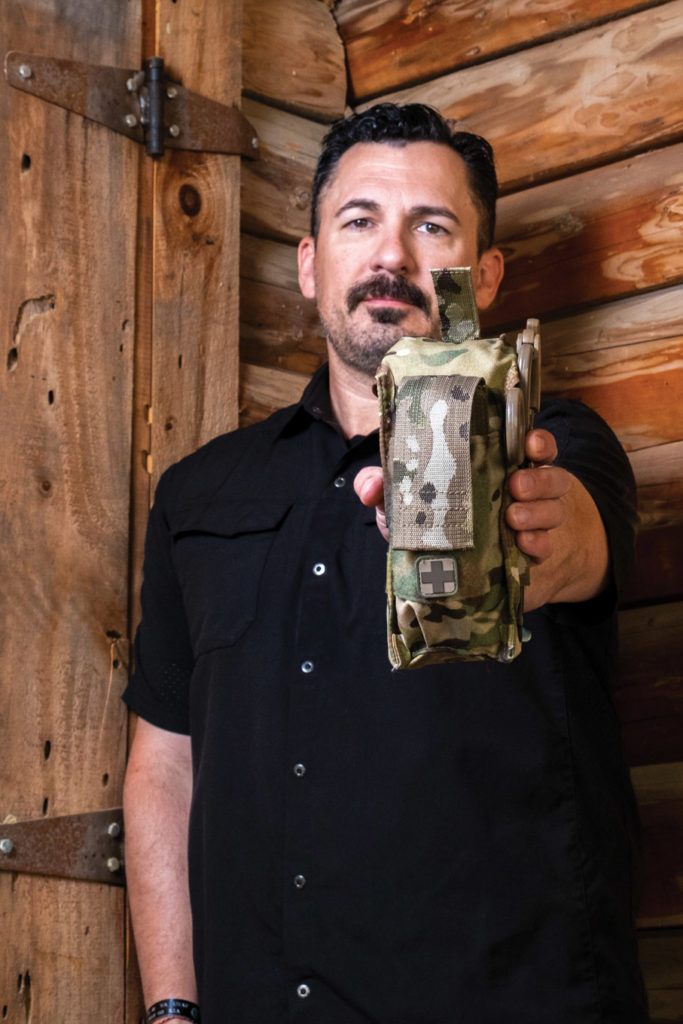
Above: Kerry holding the flagship trauma kit he designed, the D.A.R.K. (Direct Action Response Kit).
You have a great visual aid that you use in Dark Angel Medical classes: “Tourniquet the Limbs, Pack the Junctions, Seal the Box.” That’s about as simplistic as trauma care gets, right?
KD: That’s it, man. It ties into our tagline, Simplicity Under Stress. I always like to say, “Chaos breeds confusion. Confusion leads to hesitation. Hesitation leads to exsanguination. Exsanguination can lead to expiration, frustration, and maybe even litigation.”
What trauma do you think people are most likely to encounter in their lifetime?
KD: Motor vehicle accidents. Because even if you work in a wood-chipping plant or a sawmill or an industrial facility, how do you get there? You’re going to be getting there in your transportation, your automobile, whatever it may be. How many people die every year on our roads in the United States? The law of averages says that you’re probably going to be involved in an automobile accident.
Do you think basic first aid is required education in our school system, and if so, how should it be implemented?
KD: I think that a minimum of First Aid and Stop the Bleed should be taught to every high school-aged student. It should be a graduation requirement.
It’s a short, less than four-hour course teaching very basic hemorrhage control techniques, like using a tourniquet, pressure bandages, hemostatics, and things like that. Over 30,000 people a year die in United States as a result of hemorrhage that could be treated.
What do you think about arming first responders, and why?
KD: Given the social situations that we’re facing nowadays, I think it’s always been a good idea. EMS goes into some bad places, man. I think it’s a great idea as long as they want to do it, and there is some sort of formal certification program that all of them go through. There’s got to be standardization because you’re in charge of taking care of somebody else and preserving their life. If that means you had to defend that patient and/or yourself to do that, then to me, that’s upholding that creed. I’ve been doing this for 29 years, and I’ve seen a lot of bad things happen.
Has there been any legislation that’s made your job more difficult?
KD: We could perform certain procedures in the military, but when you get in the civilian sector, you feel hamstrung because we have a very, very limited scope of practice. As a medic in the Air Force, the doc will come in, look at a laceration and go, “OK, irrigate it out, give him a tetanus, and sew him up,” and they go see another patient. I’m a 22-year-old dude in there irrigating this wound, and prepping it, getting my sterile fields set up and suturing the laceration. Now, when you go from this military sector to the civilian sector, you want to help. You want to do these things because you were trained to.
But then somebody way higher than your hospital administrator says, “No, you can’t do that. I don’t care if you’re a paramedic or not; that doesn’t fall in your scope.” In the ER, sometimes I felt like I was relegated to a bedpan commando, and it’s extremely frustrating for somebody who has pride in their craft, pride in their work, and truly wants to help. That’s what drove me to become a registered nurse, so I could do more.
What’s the best advice you’ve ever received about medicine or trauma care?
KD: One of my senior medical sergeants told me years ago, “Take care of yourself. If you take care of yourself mentally, emotionally, spiritually, physically, all of the above, you’ll be a better provider for your patients.” To be a better medical provider, you’ve got to take care of yourself, and you’ve got to be a little selfish to take care of yourself before you take care of anybody else.
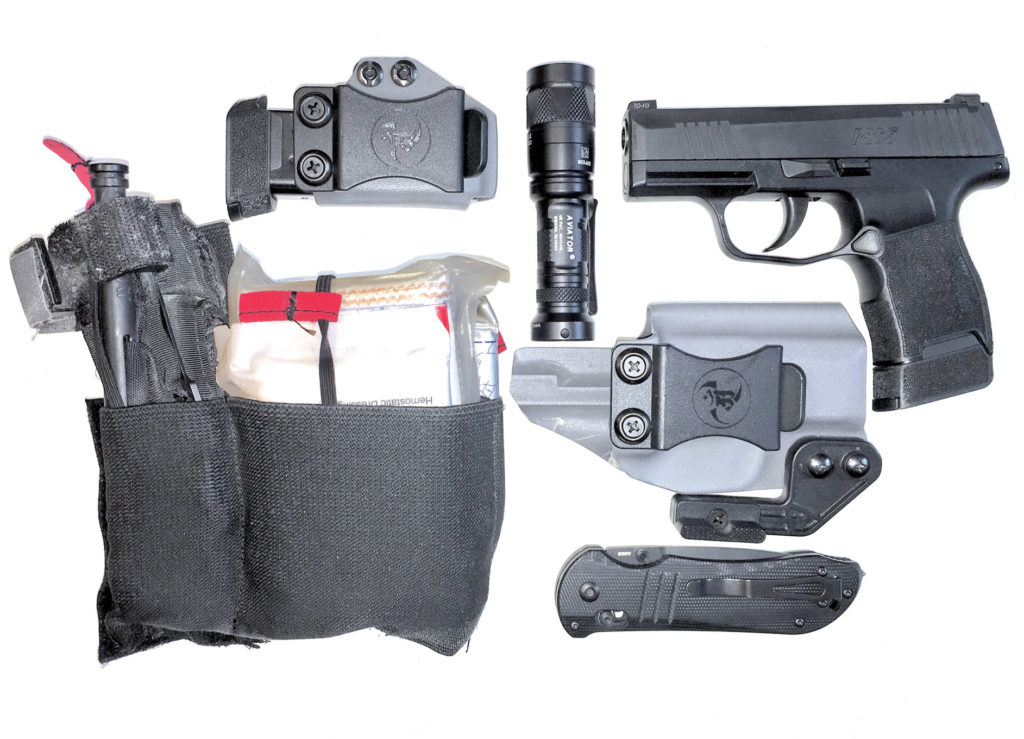

Above: Kerry’s EDC:
-SIG Sauer P365
-ANR Design Appendix Holster with Claw and ANR Design mag pouch
-Dark Angel Medical Ankle Medical Kit
-SureFire Aviator flashlight
-Benchmade 917SBK Tactical Triage knife
If someone wanted to enter the trauma care realm as a profession, what are the most important things they should know?
KD: That you will not be able to save everyone, and that’s a hard pill to swallow. People that get into this field do it because they want to help. They want to make a difference, and you take those losses extremely personally. You second-guess yourself so many times, wake up in the middle of the night going, “Well, I could have done this. I could have done that.” And that is one of the biggest things — knowing that no matter what you do, the best care you provide, you will not be able to save 100 percent of everyone. That’s probably the most crucial piece of information you can come into it with.
Outside of buying a Dark Angel Medical kit, what’s the absolute basic kit that people should have for preparedness?
KD: In our class, we have it listed out in order of importance. I would say at a bare minimum, a tourniquet (or multiple tourniquets) and some nitrile, non-latex gloves. Not black, because you can’t see blood on black gloves. You want to be able to see blood if you’re doing a blood sweep, that’s why we wear blue gloves.
Then, we will roll forward into some hemostatic agents — your combat gauze or your chitosan gauze. After that, have a pressure bandage, because a pressure bandage is very applicable in many situations. I would recommend carrying some chest seals, then I’d throw in a Mylar blanket just for hypothermia control.
What should people be on the lookout for when determining quality kit?
KD: When you’re looking for the right gear, don’t try to bargain-basement shop just because you can find stuff on Fleabay that can be super, super cheap. What are you getting? Are you getting something that’s been sitting in a CONEX box for God knows how long in 170-degree heat? Is it counterfeit? C-A-T tourniquets — the North American Rescue Combat Application Tourniquet — are probably one of the most widely counterfeited tourniquets out there. If you see something that says “combat application style” tourniquet, and you’re getting a three pack for 30 bucks, just walk away. Somebody is going to end up dying as a result of you being frugal.
What's the Dark Angel Medical process of innovation to keep pushing this field forward?
KD: In my view, a lot of the process changes just through observation. What I try to do is bring out an educational piece. I don’t try to beat them over the head with the tourniquet. It’s my responsibility to be an effective educator.
So, I use observation. I see things that are going on. Social media can be very good, or it can be very bad. I use it as a gauge to say, “This is what we need to emphasize. I’m seeing a lot of misinformation out there, and I just want to give it to you straight.”
Tell us about the philosophy behind your Dark Angel Medical kits.
KD: Medical is a way of life. It’s not a fashion statement. It truly is a lifestyle. If you want to continue to involuntarily exchange gases, put medical gear everywhere you can. If you say, “I don’t carry a med kit because of X,” that’s not a reason. It’s an excuse. And there’s absolutely no excuse for people not to carry a med kit. I try to eliminate all the bullsh*t excuses by creating my products.
Can you talk about the saves your kits have made?
KD: The saves to me are not a chest-thumping, pat myself on the back type of thing. I’m giving props to people who are putting faith in our equipment. To me, that’s the utmost compliment, that somebody has trusted our equipment, our training, and have used one or the other to give somebody another birthday. How freaking cool is that? That’s the best gift I can have. You can’t put a monetary value on that.
Like my daddy used to say, “If that don’t light your fire, your wood’s wet.” It gets me choked up. I hope people do know that I’m passionate about it, because I actually do give a crap. I do care about whether somebody makes it home. And I want people to know how to use this stuff and get our training. Those saves mean so much to us.
How many saves have you documented from Dark Angel Medical kits and training?
KD: We’re up to 120 now. I remember our very first was in December 2012. I get this letter from this Marine, and he had been in Afghanistan. He said, “I got one of your kits as a going-away gift from my mom. Before I deployed to Afghanistan, I thought it was a goofy going-away present. But I used it last week to save my best friend’s life.” That’s heavy crap right there, ain’t it? Every time I talk about it, I get teary-eyed. I knew right then that was a defining moment. This is what I’m supposed to be doing.
What has the COVID-19 situation taught you?
KD: To be ready. Aside from the deaths, it has wreaked havoc on our infrastructure. That havoc disrupted a lot of things we take for granted, like being able to go teach our classes. As a result of all of this, we can’t go teach and many people aren’t going to have this information, and that upsets me. Especially now, this information is so much more important. COVID has taught people a little more about self-reliance. What if 9-1-1 can’t get where you are because of protests? What if 9-1-1 is bogged down with many, many other calls?
At that point, you’re it and nobody’s coming to save you, so you better have your personal situation wired tight. Have the right training, the right kits, and more importantly, the right mindset. We’ve seen a big uptick in our smaller kits, EDC kits, and our ankle kits.
What does the future look like for you?
KD: We’re just going to keep on plugging along, man. We’re exploring the virtual aspect of our training, because I think that might be the wave of the future. Unfortunately, because I am very hands-on, I like to be involved with my students. We’ve got some new products coming out trying to eliminate all those excuses for not carrying medical. I foresee our company continuing to grow. I’m not going to sit down and rest on my laurels. I’m going to keep pushing and educating.
Where do you see most of your value in that future? Is it products or is it training?
KD: With us, they go hand in hand — the products and the training. If anything, what I think is going to prove itself more important is the training and the education. You can learn how to repurpose something to make a pressure bandage. I’m not trying to sound cliché, but knowledge really is power.
It truly is the power of life or death. What I’ve noticed in the last few years is that there’s been an uptake of — and I’m not diminishing these folks, I think they’re well intentioned — there’s a lot of “me too” training out there, to where maybe it’s not somebody’s passion, but they just want to put out a kit just because they can put out a kit. Some of these kits are as useless as saddlebags on a pig. What I see a lot of is style over substance, and flash over practical application. People want to go for cool and sexy, and they also want to go for cheap. Let’s not forget that.
They’re shooting a pistol that costs $3,700, but they’re sitting there betting their life that if they get hit, they can put this $12 subpar product on their limb and put it on effectively and quickly under stress. What scares me is that I see people buying into the excellent marketing. I don’t have a huge marketing budget, but I have the knowledge, I have the passion, and I tell it straight. The most important thing I can say to people is don’t buy into the hype around unproven products.
AGE: 49
HOMETOWN: Seminary, MS
FAMILY STATUS: Married,
4 children
MILITARY BACKGROUND: 10 years active duty as an Air Force Medical Service Craftsman. Airborne school, flight medic school. NCOIC at Maxwell AFB teaching at Officer Training School. Three years as a medic in the reserves.
EDUCATION: ASN-RN
PERSONAL IDOL: My dad. I wouldn’t be the man I am today without him.
FAVORITE MOVIE: Tombstone
FAVORITE BAND: Small Town Titans
FAVORITE BOOKS:
The Holy Bible
Leadership Secrets of the Rogue Warrior
by Richard Marcinko (required reading for instructor duty at Officer Training School)
Paradise General
by Dr. Dave Hnida
Alone at Dawn: Medal of Honor Recipient John Chapman and the Untold Story of the World’s Deadliest Special Operations Force
by Dan Schilling/Lori Longfritz
Robert’s Ridge: A Story of Courage and Sacrifice on Takur Ghar Mountain, Afghanistan
by Malcolm MacPherson
FAVORITE BOURBON: Blanton’s
FAVORITE MOTIVATIONAL QUOTE: “If you fail to plan, you are planning to fail.” — Benjamin Franklin
 STAY SAFE: Download a Free copy of the OFFGRID Outbreak Issue
STAY SAFE: Download a Free copy of the OFFGRID Outbreak Issue
No Comments